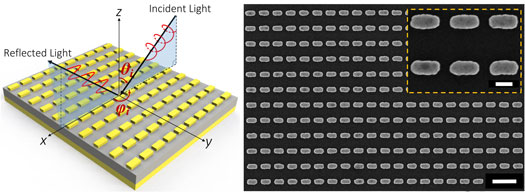| Posted: Jan 14, 2015 |
Two-dimensional metamaterial surface manipulates light
|
|
(Nanowerk News) A single layer of metallic nanostructures has been designed, fabricated and tested by a team of Penn State electrical engineers that can provide exceptional capabilities for manipulating light. This engineered surface, which consists of a periodic array of strongly coupled nanorod resonators, could improve systems that perform optical characterization in scientific devices, such as ellipsometers; sensing, such as biosensing of proteins; or satellite communications.
|
|
“We have designed and fabricated a waveplate that can transform the polarization state of light,” said Zhi Hao Jiang, a postdoctoral fellow in electrical engineering and lead author of a recent paper in Scientific Reports ("Broadband and Wide field-of-view Plasmonic Metasurface-enabled Waveplates") explaining their invention. “Polarization is one of the most fundamental properties of light. For instance, if we transform linearly polarized light into circularly polarized light, this could be useful in optical communication and biosensing.”
|
 |
| On the left, circularly polarized light is converted to a linearly polarized wave upon reflection in a metasurface-based quarter-wave plate. On the right, a top-view FESEM image of the fabricated nanostructure showing the nanorod array. (Bottom scale bar - 400 nm. Top scale bar – 100 nm)
|
|
Optical waveplates with broadband polarization conversion over a wide field of view are highly sought after. Conventional waveplates, made from multilayer stacks of materials such as quartz, have difficulty achieving both broadband and wide-angle conversion. Thin waveplates have been demonstrated, but their efficiency was low, with an average power efficiency of less than 50 percent. The team’s nanofabricated waveplates achieved measured polarization conversion rates higher than 92 percent over more than an octave bandwidth with a wide filed-of-view of around 40 degrees.
|
|
“In this paper, we demonstrated with simulation and experiment both quarter-waveplate and half-waveplate metasurfaces, which are thin artificial surfaces that operate both in the visible spectrum as well as in the near infrared,” said Jeremy Bossard, a postdoc who is a member of the team but not an author on the paper. “It also has a wide field of view, which means that if you illuminate the surface from a wide range of angles, it would still give the same reflective performance.”
|
|
As a component in an optical setup, the nanostructured waveplate offers a thinner form factor and reduced weight for space applications, a wider field of view, which can reduce the number of optical components in a system, and can achieve very wide broadband functionality in the visible to near infrared wavelength range. This represents a new state-of-the-art for optical meta-surface based devices and will enable other types of ultrathin highly efficient optical components, the authors said.
|

